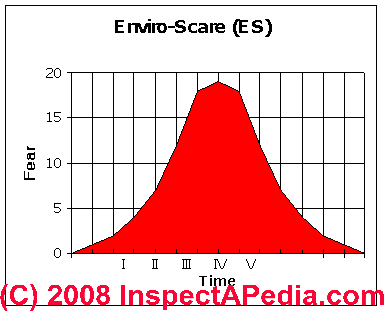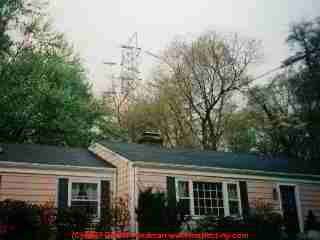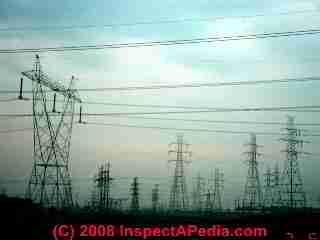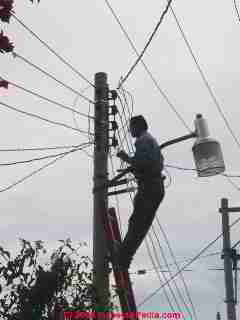 Electric Power Lines, Electromagnetic Fields: Origins of the EMF Cancer-Scare
Electric Power Lines, Electromagnetic Fields: Origins of the EMF Cancer-Scare
The Normal Curve Cycle of Public Fear of Environmental Issues and its Effect on Property Values
- POST a QUESTION or COMMENT about EMF & Cancer risks.
Origins of public fear of electromagnetic fields or EMF exposure:
This paper discusses the origins & history of consumer, home owner, & home buyer concern that electromagnetic fields - EMF - might cause cancer in humans, the effect on house prices caused by cycles of public fear about potential, imagined, or real environmental hazards.
As people become acclimated to a particular fearful topic it loses its initial shock value
InspectAPedia tolerates no conflicts of interest. We have no relationship with advertisers, products, or services discussed at this website.
Origins of Cancer Scare and Electromagnetic Fields
 Realtors listing or owners selling a property which adjoins an overhead power transmission line know that there are sometimes
very significant marketing issues because of consumer concern for potential health issues where electric power lines
expose people to strong and continuous electromagnetic fields (EMF).
Realtors listing or owners selling a property which adjoins an overhead power transmission line know that there are sometimes
very significant marketing issues because of consumer concern for potential health issues where electric power lines
expose people to strong and continuous electromagnetic fields (EMF).
A lengthy US government review of studies of the health effects of exposure to EMF concluded both that the actual level of risk was uncertain and that prudent avoidance of significant EMF exposure was warranted.
A later Swedish study of the health effects of electromagnetic fields was able to overcome important difficulties in calculating actual EMF exposure levels, and suggested that there was indeed some carcinogenic risk from EMF exposure.
The Swedish EMF study is important: it established a "dose-relationship" between the amount of exposure and the frequency of leukemia. The failure of other studies to demonstrate a specific dose-disease relationship has been used by utilities and government to assert that there is no proven relationship and no proven risk associated with EMR.
 If the public exposure to EMF has been present for a long time, what causes surges in public anxiety about this topic?
At times the release of cancer-risk studies regarding EMF and media focus on this topic have generated a cycle of public
fear about electromagnetic fields.
If the public exposure to EMF has been present for a long time, what causes surges in public anxiety about this topic?
At times the release of cancer-risk studies regarding EMF and media focus on this topic have generated a cycle of public
fear about electromagnetic fields.
The enviro-scare cycle, in my opinion, derives from periodic surges of journalist and media attention to studies of the carcinogenic effect of exposure to electromagnetic fields.
For example, there was considerable media attention to Werth's observation that living along the Denver Colorado power line right-of-way caused an EMF exposure which appeared to cause (or correlate with) a "doubling of the probability of childhood leukemia" for children living along the right-of-way of this overhead power transmission facility.
The concern for possible carcinogenic or "cancer-causing" effects of exposure to electromagnetic fields at the frequency and strength generated by power transmission lines has been studied for some time.
Some contemporary research (by epidemiologist Nancy Werth, the "Denver Study") suggested a possible (but in fact small) correlation between exposure to 60 cycle electromagnetic fields (EMF) and the occurrence of leukemia in children.
Her study found that the occurrence of childhood leukemia in the Denver Colorado area tended to cluster along and follow the path of a power distribution line which passed through a portion of the city. (I've already mentioned the "study of studies" and the important Swedish study above.)
Stating risk this way ("doubling the risk of childhood leukemia from power transmission line EMF exposure") is understandably frightening to parents, particularly those unfamiliar with statistics and the mathematics of risk assessment.
As I will amplify below, if an exposure doubles a number which is at the start infinitesimally small, say 1 chance in 10,000, then the doubled number is still infinitesimally small, say 2 in 10,000. A careful reading of the Werth study or an interview with Werth herself would almost certainly yield a more cautious opinion about the level of risk than that generated by a public reading of news reports.
But this analysis is not comforting to everyone.
The more broad topic of public fear and assessment of the level tolerable health risk has been widely discussed, and has as a component, the individual's assessment of the level of control that s/he has over the risk. So people who smoke, an act which creates a far greater health risk than power transmission lines, assess that risk as more moderate because they have a sensation of being able to "choose their poison."
Our own field measurements of EMF levels at residential properties or at specific locations within buildings have found a wide range of levels of exposure to building occupants. Remarkably, I've found that local ambient EMF levels in built-up residential areas are often quite close to the (rather low) reaction threshold discussed in the Werth and other studies, even where no obvious overhead electric power transmission facility is involved.
 However when no large transmission facility is present, the strength of
the EMF drops much more rapidly with distance from the (smaller) sources of such fields.
However when no large transmission facility is present, the strength of
the EMF drops much more rapidly with distance from the (smaller) sources of such fields.
The implications of this observation and its accuracy merit further discussion and research since there could be small local sources in buildings which also affect occupants. Some examples are listed later in this paper.
Both the difficulties of measuring actual EMF exposure and the current level of knowledge about the health effects of EMF bear thoughtful discussion, some of which I address in this paper.
Electric utility workers who spend time repairing or installing power transmission lines and transformers probably have the highest exposure to electromagnetic fields.
Consumers researching the possible health effects of EMF exposure should look closely at these studies for both the study conclusions and the care (and lack of bias) with which such studies may have been performed.
Because various parties have conflicting interests, research and advice on this topic have been confusing.
The interested parties include building owners and sellers, realtors, home buyers, power transmission companies, journalists, and scientists or researchers who themselves are supported by various funding sources. A new study of studies which tests for correlation between the interests of each funding source and the results of studies performed would be a helpful test of conflicting opinions on this topic.
Recommended Articles
- CELL PHONE RADIATION
- DEFINITIONS of EMF RF FIELD & FREQUENCY
- DEFINITIONS of HERTZ, KHz MHz GHz THz
- ELECTROMAGNETIC FIELD EMF ELF & RF DETECTION
- EMF ELECTROMAGNETIC FIELDS & HUMAN EXPOSURE
- EMF CANCER SCARE
- EMF CANCER RISK
- EMF/EMR MEASUREMENT OVERVIEW
- EMF LOCAL SOURCES MAY EXCEED POWER LINE STRENGTH
- EMF MEASUREMENT DISTANCE AFFECTS STRENGTH
- EMF MEASUREMENT INSTRUMENTS
- EMF MEASUREMENT INSTRUMENT ACCURACY
- EMF MEASUREMENT INSTRUMENT USE TIPS
- EMF MEASUREMENT PROCEDURES
- EMF MEASUREMENT STEP BY STEP
- EMF REFERENCES
- EMF SURVEY PROCEDURE
- EMF SURVEY REPORT INTERPRETATION
- EMF WORKSHEET for EMF MEASUREMENTS
- EMF WORKSHEET Example
- EMF WORKPLACE EXPOSURE
- ENVIRONMENTAL HAZARDS at BUILDINGS - home
- ENVIRO-SCARE - PUBLIC FEAR CYCLES
- HAZARD vs RISK
- RF RADIO FREQUENCY DETECTION METERS
...
Continue reading at EMF CANCER RISK or select a topic from the closely-related articles below, or see the complete ARTICLE INDEX.
Suggested citation for this web page
EMF CANCER SCARE at InspectApedia.com - online encyclopedia of building & environmental inspection, testing, diagnosis, repair, & problem prevention advice.
Or see this
INDEX to RELATED ARTICLES: ARTICLE INDEX to BUILDING ENVIRONMENT
Or use the SEARCH BOX found below to Ask a Question or Search InspectApedia
Ask a Question or Search InspectApedia
Try the search box just below, or if you prefer, post a question or comment in the Comments box below and we will respond promptly.
Search the InspectApedia website
Note: appearance of your Comment below may be delayed: if your comment contains an image, photograph, web link, or text that looks to the software as if it might be a web link, your posting will appear after it has been approved by a moderator. Apologies for the delay.
Only one image can be added per comment but you can post as many comments, and therefore images, as you like.
You will not receive a notification when a response to your question has been posted.
Please bookmark this page to make it easy for you to check back for our response.
Our Comment Box is provided by Countable Web Productions countable.ca
Citations & References
In addition to any citations in the article above, a full list is available on request.
- Electric Power Lines, Electromagnetic Fields, Cancer Risk, & "Enviro-Scare" - The Normal Curve Cycle of Public Fear About Environmental Issues - online document by DF
- A Procedure for Measuring EMF electromagnetic fields online document by DF
- "Questions and Answers about Biological Effects and Potential Hazards of Radiofrequency Electromagnetic Fields", Federal Communications Commission, Office of Engineering and Technology, US FCC, OET Bulleting 56, 4th Edition, August 1999
" Many consumer and industrial products and applications make use of some form of electromagnetic energy. One type of electromagnetic energy that is of increasing importance worldwide is radiofrequency (or "RF") energy, including radio waves and microwaves, which is used for providing telecommunications, broadcast and other services. In the United States the Federal Communications Commission (FCC) authorizes or licenses most RF telecommunications services, facilities, and devices used by the public, industry and state and local governmental organizations. Because of its regulatory responsibilities in this area the FCC often receives inquiries concerning whether there are potential safety hazards due to human exposure to RF energy emitted by FCC-regulated transmitters. Heightened awareness of the expanding use of RF technology has led some people to speculate that "electromagnetic pollution" is causing significant risks to human health from environmental RF electromagnetic fields. This document is designed to provide factual information and to answer some of the most commonly asked questions related to this topic." - original source: U.S. Federal Communications Commission Office of Engineering and Technology, http://www.fcc.gov/Bureaus/Engineering_Technology/Documents/bulletins/oet56/oet56e4.pdf - EMF RF FIELD & FREQUENCY DEFINITIONS RF and EMF measurement tools need to be properly chosen to measure the particular type and frequency of RF or EMF signal that is of interest. See EMF RF FIELD & FREQUENCY DEFINITIONS for a simple explanation of different types of radio frequency (RF) and electromagnetic frequency (EMF) types and where they are found.
- "Evaluation of Potential Carcinogenicity of Electromagnetic Fields," EPA Report #EPA/600/6-90/005B October 1990. EPA: 513/569-7562.
- "Biological Effects of Power Frequency Electric and Magnetic Fields" background paper, prepared as part of OTA's assessment of "Electric Power Wheeling and Dealing: Technological Considerations for Increasing Competition," prepared for OTA by Indira Nair, M. Granger Morgan, H. Keith Florig, Department of Engineering and Public Policy, Carnegie Mellon University, Pittsburgh, PA 15213
- "Biological Effects of Power Line Fields," New York State Powerline Project. Scientific Advisory Board Final Report, July 1, 1987.
- "Extremely Low Frequency (ELF) Fields," Environmental Health Criteria 35. World Health Organization, Geneva, 1984.
- "Electric and Magnetic Fields at Extremely Low Frequencies: Interactions with Biological Systems. In: Non ionizing Radiation Protection, World Health Organization, Regional Office for Europe, Copenhagen, 1987.
- "Electric and Magnetic Fields from 60 Hertz Electric Power: What do we know about possible health risks?," Department of Engineering and Public Policy, Carnegie Mellon University, Pittsburgh, PA 15213 1989.
- "Electromagnetic Fields Are Being Scrutinized for Linkage to Cancer," Sandra Blakeslee, New York Times, Medical Science section, April 2, 1991
- Our recommended books about building & mechanical systems design, inspection, problem diagnosis, and repair, and about indoor environment and IAQ testing, diagnosis, and cleanup are at the InspectAPedia Bookstore. Also see our Book Reviews - InspectAPedia.
- In addition to citations & references found in this article, see the research citations given at the end of the related articles found at our suggested
CONTINUE READING or RECOMMENDED ARTICLES.
- Carson, Dunlop & Associates Ltd., 120 Carlton Street Suite 407, Toronto ON M5A 4K2. Tel: (416) 964-9415 1-800-268-7070 Email: info@carsondunlop.com. Alan Carson is a past president of ASHI, the American Society of Home Inspectors.
Thanks to Alan Carson and Bob Dunlop, for permission for InspectAPedia to use text excerpts from The HOME REFERENCE BOOK - the Encyclopedia of Homes and to use illustrations from The ILLUSTRATED HOME .
Carson Dunlop Associates provides extensive home inspection education and report writing material. In gratitude we provide links to tsome Carson Dunlop Associates products and services.

